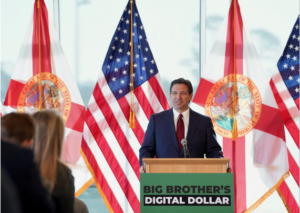 Today, Governor Ron DeSantis announced comprehensive legislation to protect Floridians from the Biden administration’s weaponization of the financial sector through a Central Bank Digital Currency (CBDC).
Today, Governor Ron DeSantis announced comprehensive legislation to protect Floridians from the Biden administration’s weaponization of the financial sector through a Central Bank Digital Currency (CBDC).
According to the press release on his website; it’s being said that “Governor DeSantis is ahead of the curve when it comes to protecting individual rights. A Central Bank Digital Currency is the cornerstone of a federal government that could track each and every transaction that happens in the world,” said State Chief Financial Officer Jimmy Patronis. “There would be no privacy, and if there is no privacy, there are no rights.
However, according to a recent survey conducted by the Global Blockchain Business Council (GBBC) in 2021, 63% of Americans have just recently heard of Bitcoin, which is a type of digital currency. While Bitcoin is not the same as CBDC, the fact that a majority of Americans have heard of digital currencies suggests that there is likely to be some level of awareness of CBDC among the US population.
This does not provide an exact percentage of people who are aware of CBDC, and it’s also important to note that awareness does not necessarily equate to understanding or support. So what is Governor DeSantis talking about?
What is a CBDC?
Central bank digital currency (CBDC) refers to a digital form of fiat currency issued by a central bank and backed by its government. Unlike cryptocurrencies, CBDCs are not decentralized and operate within a centralized payment system. As of 2021, many countries have been exploring CBDCs as a potential tool for modernizing their payment systems, enhancing financial inclusion, and maintaining monetary sovereignty. This article will examine the reasons behind the US’s need for a CBDC, the differences between wholesale and retail CBDCs, and the potential risks and benefits of a US CBDC.
Why does the US need a CBDC?
The US has been lagging behind other countries, such as China and the Bahamas, in exploring CBDCs. The Federal Reserve is considering a CBDC for several reasons, including the need to modernize its payment systems, enhance financial inclusion, and maintain monetary sovereignty. The existing payment system in the US is outdated, fragmented, and expensive, which makes it difficult for small businesses and low-income households to participate in the digital economy. A CBDC could provide a more efficient, secure, and accessible payment system for all Americans, regardless of their socioeconomic status. Additionally, a US CBDC could help maintain the US dollar’s role as the world’s reserve currency and counter the potential challenges posed by the rise of digital currencies issued by other countries or private entities.
What is the difference between a wCBDC and a rCBDC?
CBDCs can be classified into two types: wholesale CBDCs (wCBDCs) and retail CBDCs (rCBDCs). WCBDCs are designed for use by financial institutions for interbank payments, settlement, and other financial market infrastructures. On the other hand, rCBDCs are meant for use by the general public and can replace cash in everyday transactions. While wCBDCs and rCBDCs share some similarities, such as being issued and backed by central banks, they have different features and use cases. WCBDCs can help enhance the efficiency, safety, and resilience of financial market infrastructures, while rCBDCs can help improve payment system accessibility, convenience, and security for the general public.
Does the risks of a US CBDC outweigh the potential benefits?
While a US CBDC has the potential to provide several benefits, such as enhancing financial inclusion, modernizing payment systems, and maintaining monetary sovereignty, it also poses significant risks. One of the main risks is that a US CBDC could lead to bank disintermediation and financial instability. If a CBDC provides a safe and convenient alternative to bank deposits, it could lead to a significant reduction in banks’ deposit base and profitability. This, in turn, could reduce banks’ capacity to lend, which could hinder credit creation and economic growth. Additionally, a CBDC could raise privacy and security concerns if it allows for mass surveillance or becomes a target for cyber-attacks. Some experts argue that existing private-sector, open blockchain-based payment innovations, such as stablecoins or cryptocurrencies, can address many of the same issues without posing the same risks.
Would a US CBDC be regulated?
If the US decides to proceed with a CBDC, it should be designed as a regulated, fully-reserved CBDC that’s backed by USD and short-duration U.S. government obligations. A fully-reserved CBDC would ensure that the CBDC’s value is always backed by reserves and that it can be converted into USD at par value.
Overall, Governor DeSantis comments are premature. The use of a CBDC needs to be publicly tested and the details of the test results need to be published. Not to mention that most Americans do not understand the blockchain technology behind creating it.



